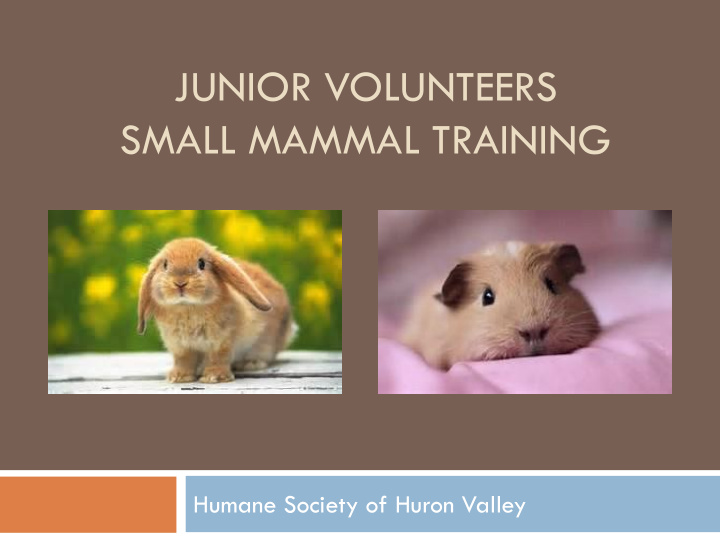



JUNIOR VOLUNTEERS SMALL MAMMAL TRAINING Humane Society of Huron Valley
Agenda Learning about small mammals How to visit Practice with our small mammals Questions and wrap up
What is Small Mammal Comforting? Hands on Socializing Some feeding
Who Will You Visit With JV Approved: Rabbits Guinea pigs Hamsters Ferrets
The Need for Small Mammal Comforting Small mammals are animals that crave gentle attention and affection from other rabbits or trusted caregivers – that’s where you come in!
It’s a scary world out there! Being scared acts as a survival technique for prey animals!
Thinking Like a Small Mammal
Why does eye placement matter? Predator Prey Ability to focus on Ability to see a larger single objects field of view Can find camouflaged Can see approaching prey easier predators Stereoscopic vision Can detect danger allows ability to judge even while feeding depth
What does that mean for us? Many small mammals don’t like being picked up and held. Don’t like loud noises or unexpected motions. Need to learn to trust you.
Why don’t we pick up the rabbits? When rabbits are lifted This can cause them to try off the ground they to jump out of your become anxious arms If handled Rabbits have very improperly, they can powerful rear legs break their own and thin fragile bones backs while being held
Be Careful! Caution must be used at all times when working with rabbits, they are quite fragile and prey animals hide their injuries. Always report all potential injuries – even if the animal does not show signs of pain .
Rabbit Body Language & Vocalization Ears Body Carriage Up Lying on side, feet out Down and together “boxing” Flattened and not lunging together Face Feet Chin rubbing Thumping Eyes closed during Fast hopping petting Standing on hind legs Head bumping Binkying
Understanding Body Language
Rabbit Body Language & Vocalization Happy Vocalizations Unhappy Vocalizations Chattering teeth while Grunting grooming or petting Growling “ Rabbit Honking ” Scream Cooing Barking Hissing
Rabbit Food Rabbits love fresh herbs and various Even if you don’t bring a greens! snack for See “Rabbit Food” handout for a them, they will be complete list of the foods you may happy for bring to feed rabbits your attention! There is often food in the cat kitchen refrigerator you can give to the rabbits
While there are certainly other foods rabbits can eat, we ask JV to only bring food from this list. This helps us monitor our rabbits diets more accurately.
Rabbit Cage Comfort Rabbits like to have an escape route, our cages only have one way in and out Rabbits are particular about their stuff – moving it around can frustrate them. Cornering a rabbit in their cage simulates dominate bunny body language, and removes their primary form of defense, running away.
What about the other small mammals? Guinea Pigs Hamsters Surprisingly active – they More vocal than rabbits: can run for 2 miles a day they purr, chirp, and hiss Hamsters hoard – they More likely to freeze than hide food in their run enclosures and cheek pouches Popcorning Listening Licking Rabbits, Guinea Pigs, and Hamsters all have similar behavior needs because they are all prey animals – but there are some differences. Rabbits are lagomorphs, a different type of animal than Guinea Pigs and Hamsters, which are rodents.
Guinea Pig Sounds
Small Mammal Visitation How to successfully socialize and provide enrichment for rabbits, guinea pigs, or hamsters at HSHV.
Small Mammal Comforting Sign into VIC HSHV staff are very The front desk will tell you which staff excited to work with our member is working with small mammals Junior Volunteers. Partner with that staff member to You can always feel coordinate the rotations of JV comfortable asking a approved small mammals and cleaning question to anyone that the room works here – front desk or not.
Small Mammal Comforting An animal will be out exercising Read notes about the animal Interact with them appropriately
Small Mammal Comforting Read a book out loud Work on homework Interact with them Bring a cardboard box to make a bunny castle Feed a few approved foods Grab a pile of towels for the small mammal to burrow into Grab new toys from the cat kitchen
Small Mammal Binder Just write: The date 1. What you 2. did with the animal What you 3. observed If you fed 4. the animal a treat And your 5. name
Small Mammal Socialization Tools Various cardboard Toys Bunny Brushes (cat zoom grooms) The Ramp Log Book Approved Treats You!
Lets meet some small mammals! Hamsters Guinea Pigs Rabbits
New shifts open to all JV Paw 2 Volunteers! No additional training required. Cat and dog JV Paw 2’s welcome! 5245 Jackson Rd Ann Arbor, MI 48103 “Tiny Lions Lounge and Adoption Center: JV Paw 2 Cat Enrichment” (Thurs, 4-5:30pm) “Tiny Lions Lounge and Adoption Center: JV Paw 2 Cat Feeding” (Tues-Fri, 4:30-5:30pm and Sat-Sun 4-5pm)
Questions?
Recommend
More recommend